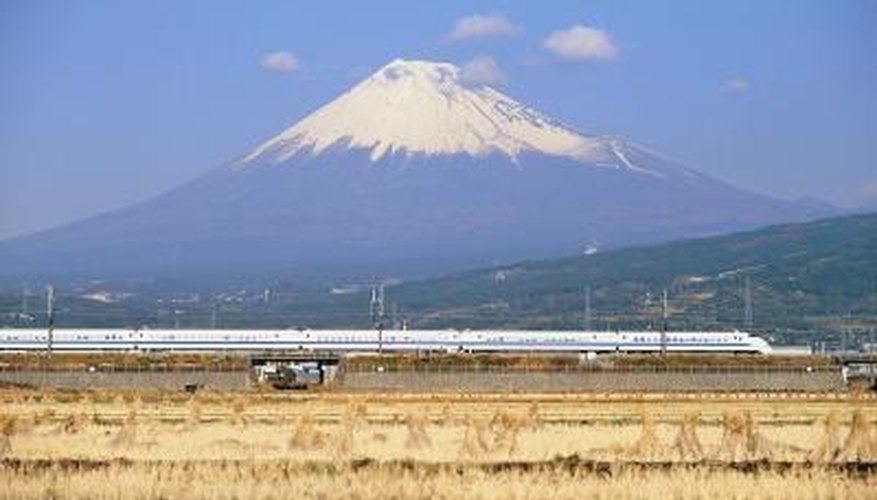For kids interested in trains, the bullet train features a wealth of interesting facts. Shinkansen, commonly known as the bullet train, gets its nickname from its rounded nose, similar to the shape of a bullet. These Japanese trains are among the fastest in the world, capable of travelling up to 186 m.p.h. The bullet train lines connect Japan from Aomori in the north to Kagoshima in the south.
The Basics
The bullet train is known for punctuality, often departing on the exact scheduled second. When the train ran 42 seconds late due to earthquakes and typhoons in 2004, the Japanese considered it disgraceful. In the 47 years since the train's opening, passengers have taken over 7.1 billion trips on the train. The original bullet trains, the 0 Series, which stopped running in 2008, made enough trips to circle the Earth 30,000 times. The train's five lines all centre around Tokyo.
- The bullet train is known for punctuality, often departing on the exact scheduled second.
- The original bullet trains, the 0 Series, which stopped running in 2008, made enough trips to circle the Earth 30,000 times.
History
The bullet train was invented by Japan's chief railway engineer, Hideo Shima, and was financed by the Japanese government and the World Bank. Shima designed the trains to feel like an aeroplane. The bullet train launched on October 1, 1964, as part of an event for the Tokyo Olympics. The first line ran 320 miles, from Osaka to Tokyo. Over the years, the railway added new types of bullet trains, including the Series 100 in the 1970s. In 1992, the Series 300, made of aluminium, debuted. The 2007 N700 trains have speeds that are virtually impossible to beat, making the trip from Tokyo to Osaka in 2 hours and 25 minutes.
- The bullet train was invented by Japan's chief railway engineer, Hideo Shima, and was financed by the Japanese government and the World Bank.
- Over the years, the railway added new types of bullet trains, including the Series 100 in the 1970s.
Speed
The secret to the train's speed is in the tracks. The trains run on even, straight tracks to prevent slowing down or stopping. The biggest cost in making the trains comes from construction of the elevated tracks and bridges needed to provide the right conditions for top speeds. The tracks run across 300 bridges and through 67 tunnels. In 1998, the new line built to cut travel time between Tokyo and Nagano cost £4 billion. It cut the previous track's travel time from three hours to 79 minutes. The trains run on electricity, which eliminates the clacking noise heard on regular trains.
- The secret to the train's speed is in the tracks.
- The biggest cost in making the trains comes from construction of the elevated tracks and bridges needed to provide the right conditions for top speeds.
Safety
Japan is located on an active seismic area and experiences frequent earthquakes. Though the earthquakes sometimes derail trains, there has never been a fatal accident on a bullet train. The train has a computer that can sense earthquakes and slows down the car. At top speeds, the train requires three minutes and 45 seconds to come to a complete stop.
- Japan is located on an active seismic area and experiences frequent earthquakes.
- Though the earthquakes sometimes derail trains, there has never been a fatal accident on a bullet train.
